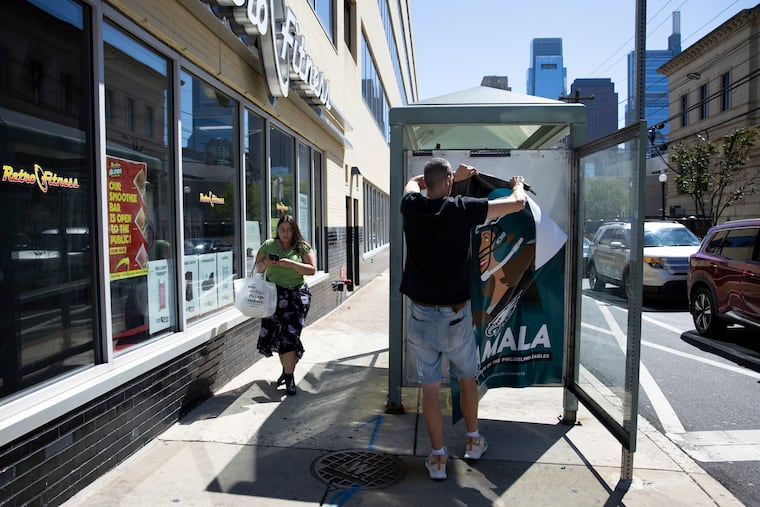City, ad agency seek answers after at least 7 hoax Kamala Harris, Eagles ads placed in SEPTA bus shelters
The artist or artists behind the Labor Day stunt at several Philly bus shelters have not come forward.

How did an artist — or artists — place at least seven hoax ads in SEPTA bus shelters over the holiday weekend claiming the Eagles had endorsed Vice President Kamala Harris’ presidential campaign?
Officials are asking questions, and the company responsible for the ad space says it may file a police report.
The ads, of course, were never sanctioned by the football team. The Eagles disavowed having any hand in the stunt Monday, when the posters reading “Official candidate of the Philadelphia Eagles” and featuring a graphic of a woman resembling Harris wearing a green Birds helmet appeared at bus shelters in Center City and North Philadelphia.
The person or group behind the stunt has not taken public responsibility for the installations.
The Harris campaign’s Pennsylvania arm did not respond to a request for comment Tuesday. A spokesperson for the City of Philadelphia’s Office of Transportation and Infrastructure Systems said that neither the Harris campaign, SEPTA, nor the city-contracted advertising agency Intersection was behind the stunt.
“Whomever is responsible for the illegally placed posters broke into the securely covered shelter ad space and somehow placed the posters in the space,” said Matt Cassidy, communication manager for the office.
Officials identified at least seven Harris-Eagles advertisements at bus shelters throughout the city. Cassidy planned to visit some of the locations Tuesday, as the office questions how the artist may have breached the protective plexiglass barrier covering the ad spaces.
And following social media speculation over whether the hoax ad ran digitally at one shelter, Cassidy dispelled the rumor, saying that there was no “digital breach” and that the poster had been placed overtop the shelter’s digital screen.
While the city owns SEPTA’s bus shelters, it contracts with Intersection to place ads. Both parties jointly review the finished product that ends up facing the public, according to Cassidy. City policy does not permit political advertisements.
Intersection said that it had removed the ads as of Tuesday afternoon, and that its staff was searching for others. The agency considers the stunt an act of vandalism as well as theft, according to an Intersection spokesperson, because the ads’ creator removed existing advertising and took up ad space. The agency is considering filing a police report.
“The revenue generated from these ads is vital, as a portion goes to the city and helps maintain the bus shelters, which are valuable amenities for the citizens of Philadelphia,” the Intersection spokesperson said. “When ads are illegally removed or replaced, it undermines our ability to generate revenue and support the overall bus shelter program.”
Philadelphia street art blogger Conrad Benner said the Harris-Eagles stunt was part of a lineage of art installations that have challenged and critiqued public advertising since the 1980s.
And the city’s bus shelter advertising boxes, he said, “aren’t Fort Knox.” The boxes, according to Benner, use a similar key that artists around the city have easily replicated to pull off similar stunts in recent years.
An Intersection spokesperson said the agency’s ad boxes are locked but “occasionally people find a way to unlock the ad box and insert unauthorized copy.”
Listing nearly a dozen examples of similar stunts by other artists, Benner mentioned the work of Kid Hazo, the street artist behind hoax bus shelter ads critical of the rideshare company Uber and poking fun at the 2016 Democratic National Convention.
Benner, founder of the “Streets Dept” blog, also mentioned artist Joe Boruchow’s 2019 bus shelter rendering of the Union League of Philadelphia, in which a Confederate flag flies above a drawing of the private club in what the artist described as a critique of the Republican Party.
“You wouldn’t have dozens of artists doing this if it wasn’t so easy to do,” Benner said. “You’re not breaking the glass, you’re not unscrewing screws, you’re opening the door.”